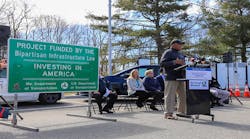Chicago-based Midwest High Speed Rail Association (MHSRA) and local leaders recently proposed a $12 billion, 220-mph high-speed rail line that would cut the ride between Chicago and St. Louis to a little more than 2 hr. The ultrafast electric-powered service would also serve Kankakee, Champaign-Urbana, Decatur, and Springfield, and would complement new 110-mph lines already proposed for other parts of Illinois and the Midwest.
MHSRA is asking the State of Illinois to solicit $10 million in Recovery Act funds to conduct a detailed alternatives analysis and environmental study for the Chicago/St. Louis route, which would pave the way for a formal request of funding through Congress.
“Ultrafast trains are green, efficient transportation that bring people closer, stimulate the economy, and create jobs,” says Rick Harnish, executive director of MHSRA. “It's the right investment at a time when we look to curb our emissions and our dependence on oil, while helping jump-start growth.”
Any planning and construction funds should be allocated in addition to — and not instead of — monies already planned for improvements to 110 mph along several corridors around the country, said MHSRA officials.
The proposal is based on a study commissioned by MHSRA and conducted by transportation planning specialists TranSystems. It concluded the best route for achieving 220-mph speeds with existing rights-of-way was to link St. Louis and Chicago via Decatur, Champaign-Urbana, and Springfield.
Although the line through Champaign is considered the most feasible and cost-effective for 220-mph service in Illinois, the association also urged the state and federal officials to consider studying bringing the technology to other Illinois corridors, including the Chicago-Springfield line that goes through Bloomington-Normal, which is already being considered for upgrades to 110 mph.
The 220-mph service proposed would bring Champaign within 50 min. of Chicago and 1 hr 14 min. of St. Louis, with Decatur about 1 hr from either city. Springfield would be 1 hr 23 min. from Chicago and only 41 min. from St. Louis. Those times make every leg of the route competitive not only with driving, but also with flying (when taking into consideration flight times and airport waits).
The current Amtrak line along that same right-of-way is limited to 79 mph, but the terrain and trajectories allow for much higher speeds with newer proven technology used successfully in Europe and Asia.
Furthermore, U.S. Department of Transportation figures show high-speed rail consumes nearly 10 times less fuel than automobiles and six times less than airplanes. Based on projects elsewhere in the country, it is estimated the project would create up to 60,000 construction-related jobs and 170,000 permanent jobs. Building the new trains in the United States could also help reinvigorate the manufacturing sector.


